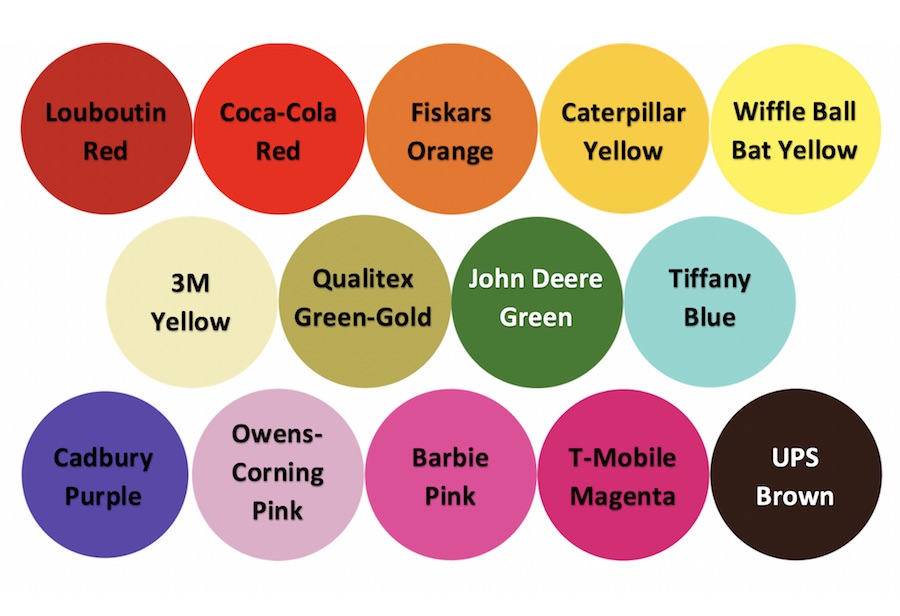Yes, under certain circumstances you can trademark a color.
Trademarks are defined by the Lanham Act as “any word, name, symbol, or device, or any combination thereof” that is used to “identify and distinguish” one’s goods or services from those of other sources. While colors are not included within the statutory definition of trademarks, and were traditionally barred from obtaining trademark protection, since 1995, singular colors and color combinations can be trademarked as part of a product, package or service, if, like any other trademark, they (1) serve a source
identification function, and (2) do not serve a merely decorative or utilitarian purpose.
Examples of protectable color marks include: red soles for women’s high-heel dress shoes, where the rest of the shoe is not also red (Louboutin); pink fiberglass insulation (Owens-Corning); red knobs on cooking appliances (Wolf); light blue for jewelry boxes (Tiffany); brown for parcel delivery trucks and uniforms (UPS); magenta for telecommunications services (T-Mobile); and orange for scissor handles (Fiskars).
Color marks require proof of “secondary meaning.” In addition to the criteria listed above, which apply to all trademarks, a color can only be trademarked in connection with a particular good or service if, like “merely descriptive” marks (which are not “inherently distinctive” and therefore do not immediately qualify for trademark protection), it has achieved “secondary meaning.” That is, a color can be trademarked in connection with a particular good or service if, through the use of the color over time as applied to a particular good or service, the public has come to associate that color with a particular source.
Secondary meaning can be difficult to establish.
As General Mills recently learned when it was denied trademark protection for the yellow color of its Cheerios cereal boxes, which it has used since 1945, if certain colors or color combinations are already widely used with respect to a particular type of good or service, or particular elements thereof, it will be difficult for any one person to establish secondary meaning. On the other hand, if colors are not already widely used within a particular market for some good or service, or if the applicant’s use of a particular color or color combination is unusual or elaborate, such as a green and white striped can of shaving cream, then it is more likely that secondary meaning can be shown.
Generally, secondary meaning is best shown by a high volume of advertising involving the color mark, as well as consumer surveys reflecting that a high degree of relevant consumers associate that particular color or combination (in connection with a certain good or service) with the applicant.
A color mark cannot be functional.
Like all marks, a color mark cannot obtain trademark protection if it performs a utilitarian function, no matter how distinctive the use of the color may be or how much secondary meaning it may have obtained. The Supreme Court has said that a mark is functional, and therefore unprotectable, if it is either essential to the good or service, or affects its cost or quality. Lower courts have refined the test to more broadly ask whether denying competitors the ability to use the feature would put them at a competitive disadvantage. For color marks in particular, trademark protection may be denied if the color indicates a characteristic of the good or service, such as its size, strength or capacity. Below are some examples of color marks that have been denied trademark protection based on functionality:
- Amber-colored mouth wash, because the color indicated the flavor;
- Black bottle for soft drinks, because the color keeps out light;
- Color-coded automobile replacement parts, because the colors assist in installation;
- Pink ceramic hip implants, because the pink color was a natural by-product of the devices’ components (i.e., it was essential to the product);
- Purple sandpaper, because the color signified the grit size of the abrasive;
- Red filter on end of a flashlight, because it served as a safety and warning light; and
- Yellow and orange telephone booths, because they increase visibility to pedestrians and motorists.
How to define a color.
While certain colors, such as Chinese Red or Cobalt Blue, may seem sufficiently definite to some, courts appear now to prefer the use of more scientific processes for defining color shades, such as the Pantone Matching System, which is an ink matching technique consisting of 1,114 colors. The Pantone Matching System can be used to define the particular shade of a color mark, as well as the scope of protection around it, for example ten shades on either side of the target color. This is useful not only to courts and counsel in evaluating likelihood of confusion (i.e., the test for trademark infringement), but also to manufactures and advertisers to ensure correct and consistent use of the color mark.
Should you trademark a color?
Generally, when applying for trademark protection, it is better to not claim any particular color as part of the mark, unless it is essential to, or is the distinguishing element of, the mark. Trademarks that are not limited to any one color provide the broadest level of protection, as the owner will then have the right to use (and prevent others from using) the mark in any color. By including color as an element of a trademark, the owner is actually limiting its right to use the mark to that specific color, which will also make it more difficult to prevent competitors from using the mark in other colors.
On the other hand, for some goods and services, where the target mark may be completely undistinctive without the use of a particular color (e.g., women’s high-heel dress shoe soles), using and trademarking a particular color may be a very wise thing to do, as it can make a good or service more distinctive, increase brand awareness, and transform the unprotectable into the protected.
File your trademark application ASAP.
Applicants need not wait until they can prove secondary meaning, or even begin using a particular color in commerce, to file a trademark application for their color mark. Applicants can file a trademark application with the U.S. Patent and Trademark Office (“USPTO”) even before the mark has acquired distinctiveness. If the USPTO determines that the mark is not yet distinctive but could be if used consistently over time, the mark may be registered on the USPTO’s “Supplemental Register,” which is reserved for marks that are capable of serving as source-identifiers (i.e., as trademarks), but have not yet achieved or shown the secondary meaning necessary to be placed on the “Principal Register,” which is reserved for distinctive trademarks. Ultimately, an applicant will want its trademark registered on the Principal Register as it provides a greater level of protection.
Filing an application to register a color mark, even before the mark is used, can still be beneficial. That will provide the applicant with the benefit of an earlier filing date than if one waits to file until the mark actually achieves secondary meaning. This earlier-filing date can provide a huge benefit if competitors subsequently begin using the same or similar colors in connection with their own products or services. If the color mark is registered on the Supplemental Register, once the mark has achieved secondary meaning, which is typically after at least 5 years of continued use, the applicant can reapply to register the mark on the Principal Register.
Speak with a trademark attorney early on. Before making the substantial investment into using a particular color as a mark in connection with one’s goods or services, brand owners should first speak with a trademark attorney to make sure the color mark can actually be registered. Trademark attorneys have access to powerful comprehensive research tools that can check whether a color mark is available for use and whether there are any similar color marks already being used in the relevant market that could present hurdles to registration, or even lawsuits from competitors. Trademark attorneys can also provide guidance as to whether the planned use of a color can be protected, or if it should be modified to increase the probability of registration, as well as develop strategies to shorten the path to secondary meaning. As with any trademark, it is much more cost-effective to involve a trademark attorney at the outset, before problems arise and changes to one’s brand become necessary.

![[IPWatchdog Logo]](https://ipwatchdog.com/wp-content/themes/IPWatchdog%20-%202023/assets/images/temp/logo-small@2x.png)


![[Advertisement]](https://ipwatchdog.com/wp-content/uploads/2024/05/Quartz-IP-May-9-2024-sidebar-700x500-1.jpg)
![[Advertisement]](https://ipwatchdog.com/wp-content/uploads/2024/04/Patent-Litigation-Masters-2024-sidebar-last-chance-700x500-1.jpg)

![[Advertisement]](https://ipwatchdog.com/wp-content/uploads/2021/12/WEBINAR-336-x-280-px.png)
![[Advertisement]](https://ipwatchdog.com/wp-content/uploads/2021/12/2021-Patent-Practice-on-Demand-recorded-Feb-2021-336-x-280.jpg)
![[Advertisement]](https://ipwatchdog.com/wp-content/uploads/2021/12/Ad-4-The-Invent-Patent-System™.png)






Join the Discussion
3 comments so far.
Dictionariesarefriends_notfood
July 19, 2018 09:56 amI also think the members of the “trademark is not a verb” crowd are . . . strange. Before I commented, I confirmed that trademark is indeed, a noun and a verb, just as is patent.
VERB . . . 1. provide with a trademark.
“Was this not a thing” (as a the younger kids say)?
Gene Quinn
July 16, 2018 11:35 amTom C-
You had it right when you called your point “persnickety”.
To say that one does not apply for trademark protection is at best pedantic, at worst misleading. Obviously, federal trademark protection is applied for every single day of the week. The fact that those who are applying for federal trademark protection at the USPTO already have common law rights doesn’t change the fact that they are applying to receive a federal registration, which carries with it far greater rights than simply relying on common law or state rights.
Tom C
July 16, 2018 10:56 amGood article, except for the following persnickety, but important, point.
“Trademark” is not a verb. It’s a noun. When you use “trademark” as a verb, it creates a latent ambiguity as to whether you are saying that (a) you USE the term, symbol, etc. as a trademark, or (b) you have obtained a federal registration for it. Relatedly, one does not “apply for trademark protection.” Trademark protection arises from USE of a valid mark. Registration supplies addition procedural and remedial benefits.